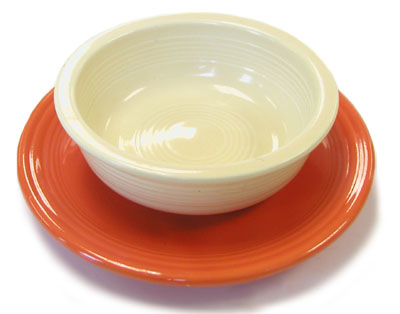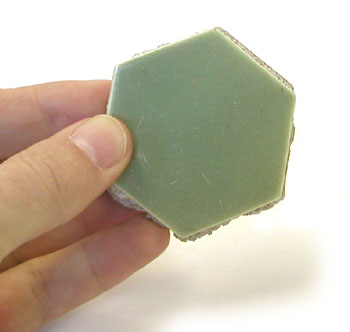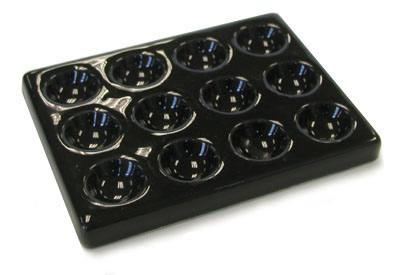Ceramics
General Information about Uranium in Ceramics
Paul Frame, Oak Ridge Associated Universities
General
Ordinary ceramics often contain elevated levels of naturally occurring radionuclides, e.g., K-40 and the various members of the uranium and thorium decay series. Because of this, health physicists who are conducting radiation surveys expect to see higher readings when they are making measurements over ceramic tiles and similar materials. Sometimes the higher readings are due to uranium in the glaze, sometimes they are due to the radionuclides in the clay that was used to produce the ceramic. For example, I was once at a truck weigh station when a vehicle carrying toilets set off a radiation monitor. As another example, health physicists at Oak Ridge National Laboratory reported excessively high readings while surveying newly purchased urinals for the men’s restrooms. Perhaps they should have been spelt “uranyls?”
Ceramics can be particularly radioactive if some compound of uranium (e.g., uranium oxide, sodium urinate) has been used to impart color (e.g., orange-red, green, yellow, black) to the glaze. It is widely known that uranium was used in the glaze of orange-red Fiesta dinnerware, but uranium glazes have also been used other types of ceramics: wall and floor tiles, pottery, laboratory ceramics, etc. The glaze can serve two functions: it provides color, and it seals the ceramic.
The use of uranium in ceramic glazes ceased during World War II and didn’t resume until 1959. In 1987, NCRP Report 95 indicated that no manufacturers were using uranium-glaze in dinnerware.
Potential Doses
Although the uranium in the glaze emits gamma rays, alpha particles, and beta particles, the gamma and alpha emissions are weak. The beta particles are the easiest to detect, and they are also responsible for the bulk of the radiation exposure to those handling ceramics that employ a uranium glaze.
NCRP Report 95 reported the following measurements for dinnerware employing uranium glazes: 0.2 to 20 mrad per hour on contact as measured using film badges.
Measurements of the radioactivity of ceramics that are reported in mR/hr are difficult to interpret unless it is known whether or not the detector was responding to beta particles. The exposure rate, in mR/hr, is defined for x-rays or gamma rays. It is not defined for betas. If a measurement is reported in mR/hr, the detector should not be responding to beta particles.
NUREG/CRCP-0001 reported a measurement of approximately 0.7 mR/hr at 25 cm from a Fiesta red dinner plate. It also reported the results of an Oak Ridge National Laboratory analysis that predicted 34.4 mrem/year to a dishwasher at a restaurant using ceramic plates containing 20% uranium in the glaze, 7.9 mrem/year to the waiters, and 0.2 mrem to a patron for a four hour exposure.
It is likely that the major health issue associated with this dinnerware is not the radiation exposures, but the ingestion of uranium or other metals that have leached into food or drink in contact with the dinnerware. One FDA study measured 1.66 x 10-5 uCi/ml in a 4 % acetic acid solution in contact with the ceramic dinnerware for 50 hours—this exceeded the ICRP’s maximum permissible concentration (MPC).
One common misconception is that a uranium-containing glaze can be a source of radon-222. This is incorrect because the glaze contains chemically purified uranium, not the complete uranium series. Chemically purified uranium contains: U-238 plus its two short-lived decay products, Th-234 and Pa-234m; U-234; and U-235 plus its decay product Th-231. Since Ra-226 is not present, there is no radon (Rn-222) production. It is true that the clay used to produce the body of the ceramic (rather than the glaze) can be a source of radon, but this is true for all ceramics, with or without a uranium glaze.
Pertinent Regulations
10 CFR 40.13 Unimportant quantities of source material.
(c) Any person is exempt from the regulation in this part and from the requirements for a license set forth in section 62 of the Act to the extent that such person receives, possesses, uses, or transfers:
(2) Source material contained in the following products: (i) Glazed ceramic tableware, provided that the glaze contains not more than 20 percent by weight source material; (ii) Piezoelectric ceramic containing not more than 2 percent by weight source material; (iii) Glassware containing not more than 10 percent by weight source material; but not including commercially manufactured glass brick, pane glass, ceramic tile, or other glass or ceramic used in construction;
Reference
Harry McMaster. Earthenware Dishes and Glaze Therefor. U.S. Patent No. 1,890,297, December 6, 1932.
-
Cloisonné Jewelry Cloisonné Jewelry

-
Fiestaware Fiestaware

-
Radioactive Tiles Radioactive Tiles

-
Uranium Containing Dentures Uranium Containing Dentures

-
Uranium Containing Spot Plate Uranium Containing Spot Plate

